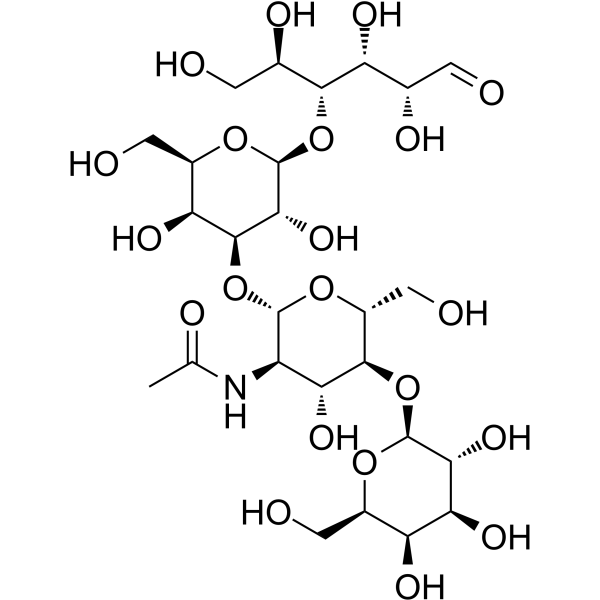13007-32-4
| Name | β-D-Gal-(1→4)-β-D-GlcNAc-(1→3)-β-D-Gal-(1→4)-D-Glc |
|---|---|
| Synonyms |
LACTO-N-NEOTETRAOSE
Lacto-N-neo-tetraose beta-D-Gal-(1->4)-beta-D-GlcNAc-(1->3)-beta-D-Gal-(1->4)-D-Glc |
| Description | Lacto-N-neotetraose (LNnT) is an endogenous metabolite. Lacto-N-neotetraose can inhibit TNF-α induced IL-8 secretion in immature epithelial cells. Lacto-N-neotetraose has anti-inflammatory avtivity, and can improve the wound closure[1][2][4]. |
|---|---|
| Related Catalog | |
| Target |
Endogenous Metabolite[1], TNFR1[2]. |
| In Vitro | Lacto-N-neotetraose (5 mg/mL, 24 h) induces IL-8 secretion in T84 cells[2]. Lacto-N-neotetraose (5 mg/mL, 24 h) reduces TNF-α induced IL-8-secretion with 38% in FHs 74 Int cells[2]. Lacto-N-neotetraose binds TNFR1 (Tumor necrosis factor receptor 1) with a Kd value of 900 ± 660 nM[2]. Lacto-N-neotetraose (5 mg/mL, 24 h) attenuates TNF-α induced inflammation by TNFR1 ectodomain shedding in FHs 74 Int cells[2]. |
| In Vivo | Lacto-N-neotetraose (100 μM, intratracheal administration for 24 h) reduces the abundance of Streptococcus pneumonia in the lungs of pneumonia rabbits[3]. Lacto-N-neotetraose (100/200 μg, Intradermal injection, at 3, 7, 14, and 21 days post-surgery) increases the wound closure rate on day 7 post-wounding[4]. Animal Model: Rabbit model of pneumonia[3] Dosage: 100 μM Administration: Intratracheal administration for 24 h Result: Decreased by ~2 logs the bacterial load in the lung at 48 h after challenge. Eliminated the extensive, edematous right middle lobe lesion evident at 48 h in control animals. Animal Model: Mice with symmetric full-thickness wounds Dosage: 100, 200 μg Administration: Intradermal injection, at 3, 7, 14, and 21 days post-surgery. Result: Exhibited better healing score, follicle formation, and lower epidermal thickness index (H&E staining). |
| References |
| Density | 1.72g/cm3 |
|---|---|
| Boiling Point | 1173.6ºC at 760mmHg |
| Molecular Formula | C26H45NO21 |
| Molecular Weight | 707.63000 |
| Flash Point | 663.6ºC |
| Exact Mass | 707.24800 |
| PSA | 356.70000 |
| Vapour Pressure | 0mmHg at 25°C |
| Index of Refraction | 1.668 |
| Storage condition | 2-8°C |
| RIDADR | NONH for all modes of transport |
|---|---|
| WGK Germany | 3 |
